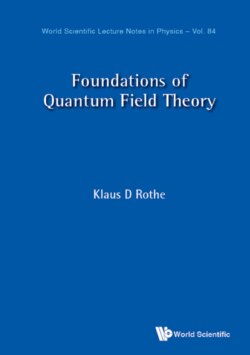Читать книгу Foundations of Quantum Field Theory - Klaus D Rothe - Страница 15
На сайте Литреса книга снята с продажи.
2.4Finite irreducible representation of
ОглавлениеIn order to obtain a characterization of the irreducible representation , we define the new operators
Note that and (see (2.22)). It then follows from the commutation relations (2.23) that
The operators and thus satisfy two Lie algebras which are decoupled from each other. Correspondingly, there exist two Casimir operators, 2 and 2, which commute with all elements of the group. Their eigenvalues thus serve to classify the irreducible representations of . In the irreducible basis, the matrix elements of the generators and are evidently given by the well-known expressions known from the rotation group:
where a and b take the values
In particular, we have
For the operators and i these matrix elements read from (2.27)
From these matrix elements we then obtain the corresponding representations of finite Lorentz transformations by simple exponentiation, in a way analogous to (2.24),
or compactly
with
where denotes the direction of the boost. The matrices D(A, B) exhaust all possible finite dimensional representations of . They are non-unitary except for the trivial representation D(0,0)
Example 1
Consider the representation (A, B) = (j, 0). In that representation the operator is realized by zero or . This possibility is allowed by the commutation relations (2.28). One has
with
Example 2
Consider the representation (A, B) = (0, j). In that case = 0 or , and the Lorentz transformations are realized by
with the corresponding matrix elements for :
The above representations will play a central role in the chapters to follow. We observe that
We introduce the following notation8
We then have in particular
as well as
For a pure rotation
The case
For the case of j = 1/2 it is easy to give an explicit expression for the matrices and representing a boost, since in that case the matrices representing are just one half of the Pauli matrices (4.4):
Using
we have
or recalling (2.14), we may write this also as
We thus conclude that
Defining
we may thus write the matrices (2.34) in the compact form
These matrices will play a central role in our discussion of the Dirac equation in Chapter 4. Their explicit form is most easily obtained by returning to (2.35) and noting that
Now,
Hence
Similarly
These explicit expressions will prove useful in our discussion of the Dirac equation in Chapter 4.
For the rest of these lectures we set c = 1.
